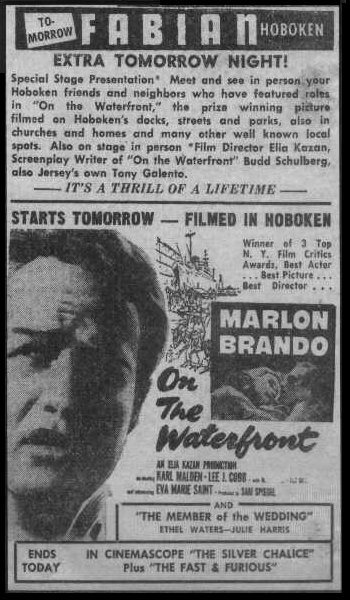 |
 About the Movie and Hoboken
About the Movie and Hoboken
By Nicholas Acocella
With acknowledgments to
Leonard A. Luizzi and Frank Pizzichillo
One of the glories of the history of Hoboken is that the 1954 motion picture On the Waterfront was filmed almost exclusively in the city. The film won academy awards for:
- Best Picture: On the Waterfront to producer Sam Spiegel and Columbia Pictures
- Best Actor: Marlon Brando
- Best Supporting Actress: Eva Marie Saint
- Best Director: Elia Kazan
- Best Story and Screenplay: Budd Schulberg
- Best Black-and-White Cinematography: Boris Kaufman
- Best Black-and-White Art Direction and Set Direction: Richard Day
- Best Film Editing: Gene Milford
|
In addition, Karl Malden, Lee J. Cobb, and Rod Steiger were all nominated for best supporting actor, the first time three performers in the same film were so named. Brando, Kazan, and the picture itself also earned New York Film Critics awards and Golden Globe awards for the year. Kazan added a prize from the Directors Guild of America, while Schulberg also took the annual writers Guild of America honors.
On the Waterfront was more than a blockbuster; it was a film event. It brought to the screen the best of the Method, the naturalistic acting style taught by Lee Strasberg and others in the Actors Studio. Also, it is arguably the best of the social protest films, shot in grainy black and white, of the 1950s. What's more, the content -- an exposure of the widespread corruption in the shipping industry -- was shocking. For those too tough or too savvy (i.e., Hobokenites) to be surprised by conditions on the waterfront, one scene attacked conventional delicacy in another way: when Terry Malloy (Brando) tells Father Barry (Malden) to "go to hell" -- not once, but twice. While many of the same theater patrons had heard Clark Gable, in the penultimate scene of Gone With the Wind, use the D-word 15 years earlier, Malloy-Brando's repeated suggestion nevertheless startled mid-1950s sensibilities because he was, after all, talking to a priest!
A good question might be, "Why Hoboken?" After all, the country's premier harbor was just across the river in New York City. There are three good reasons why the production company chose to film here. The first was that the pier used in the film was abandoned and unused (although the Port Authority of NY and NJ was in the process of rebuilding). The second reason is that they received complete cooperation from both the city and the local union. The third reason is that the Mayor of Hoboken wanted to prove a point. Contrast these reasons with Manhattan, where there were no inactive piers, and, given the nature of the subject matter, cooperation from the unions was extremely unlikely. On the other hand, Hoboken Mayor John Grogan was a union man himself, and wanted to show the world that his unions and that he, personally, were completely honest. At the time, the Mayor was also National President of the Maritime Shipbuilders Union, and International Vice President of the International Longshoremans' Association (ILA).


|
|
 |